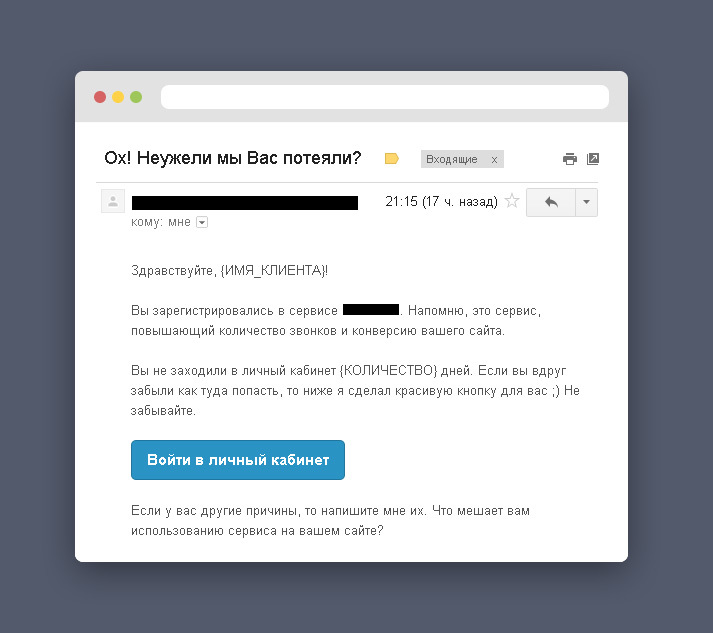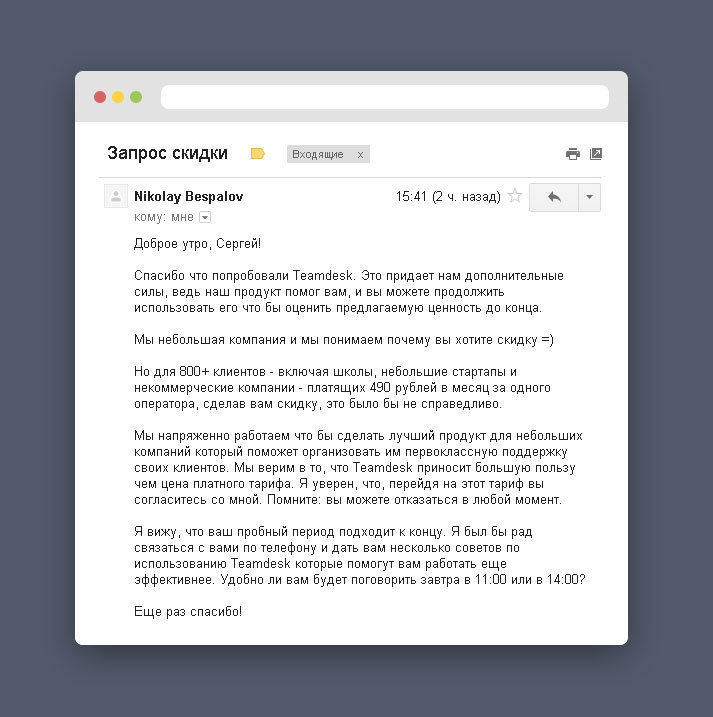4 scripts to handle the most complex Email from clients
Friends, on duty we follow the useful materials about the support service in English. To our great regret, there are very few really useful and necessary materials in Russian. Therefore, we decided to correct this injustice and contribute to the development of customer service in Russia.

Today we are posting an excellent article on Groove’s customer support blog . The material is about how to correctly and incorrectly use scripts in Email support. Also given are the response templates to the most tricky questions of customers about discounts and features, answers to angry letters and “when everything was gone”.
From translator: for the convenience of readers, we translated and slightly adapted screenshots and script texts. Enjoy reading the Teamdesk customer support system .
That's why I love scripts and templates: instead of explaining the strategy conceptually, the script helps you see the concept in action. An example can simplify the understanding and understanding of the message. I don’t think there is an easier way to demonstrate the principles of good customer service responses.
That's why I hate scripts and templates: if you copy and paste templates that you found somewhere in your letter, then you may lose the opportunity to build genuine human relationships with your client. Worse, you run the risk of making an unforgivable mistake. Here is an example:

How would you feel if you found a letter in your inbox? Apparently, the email template engine did not work.
Imagine that we are sitting in the same room, and I just told you a really funny story. Three weeks later, communicating with friends, you decide to tell them that very funny story.
Do you translate her word for word? Of course not! You will recall the structure of the story and the brightest moments in it, but nevertheless tell it in your own words. This is natural, because you remember the most important moments of the story and you can tell it in your own manner, and literal retelling will simply be of no interest to anyone.
Here's how you should approach using scripts. Read them, remember them and return to them. Disassemble them for better memorization of key points. But change them for yourself. Your customers will appreciate this, and your strategy will work better, much better. Now to the scripts ...
Derek Halpern said discounts could ruin your business . And I agree: our goal is always to increase the value of our product, but not to lower it. Discounts are a great way to achieve the latter.
Think about the services that send discount coupons all the time. This strategy may work for them, but this is not our approach. When a client asks for a discount, we will react something like this:

Why does it work? We empathize (we understand what the client feels), a personal letter (we included information about the client and his account) and we increase the value (during the consultation by phone we suggest increasing the known value for the client).
Every week we receive dozens of requests for the implementation of a particular functionality. Implementing all functionality requests is not possible, and it’s not particularly smart to do so. Many requests do not coincide with the fact that we already know what most of our customers want, or these requests do not look particularly useful. But direct rejection is a really bad decision.
And this does not mean that the ideas of your customers are stupid, useless or uninteresting. Your customers are the best source from which you can draw inspiration for the next step. But you can make them feel that their ideas are uninteresting. All you need to do is make up the rejection phrase incorrectly.
We tested 10+ completely different approaches to this situation, and one of them still stands above the rest:

Why does it work? This is personal (we proved that we read and understood the idea of the client), it is positive, and it still carries value to the client.
Everyone who has been working in customer support for quite some time has had to deal with a very angry customer. Sometimes a customer is angry because he feels infringed on what you or your company are doing. Sometimes a client had a bad day, and you become an easy target for him.
Everyone has days when things go wrong, these days we cannot feel good. Customer Support Trainer Robert Buckal offers a simple system called CARP for working with angry customers.
CARP is:
The first step should be directed to control ( the Control ) situation. This means that customer anger should not affect your own behavior. Those. no need to get angry in return.
The next step is to acknowledge ( Acknowledge ) what the client feels. Empathize and make it clear to the client that you fully understand why he is upset.
Thirdly, go in the conversation to the most important ( Refocus ): to the problem.
And finally: work on finding a solution to the client’s problem ( Problem-Solve ).
Here is a real example of how you can turn an angry customer into a happy one.

Why does it work? If you follow the CARP system, then control, recognition, change of focus and problem solving will help the client feel better, because his appeal is taken seriously.
Any business knows that depressing feeling when all the letters in the mailbox are from angry customers. And they all ask one and the same question: Why the product for which they pay does not work! It was terrible when a mail collector fell a few months ago. Fortunately, the letters we sent saved us. Here is the letter we used:

Why it works : This letter was informative (includes all the details and the exact time, without confusion), empathic (we made it clear that we knew how terrible it was for our customers), it contained an apology.
Note : it is also important to say the right words in this situation, that you control the status of each client, that you are open and do not keep them in the dark, and as soon as all the reasons become known, you will fully inform them.
These are examples of specific situations, but the concept can be applied to most customer support tasks. In conclusion: dig deeper to understand the customer and respond as you would like to be answered.

Today we are posting an excellent article on Groove’s customer support blog . The material is about how to correctly and incorrectly use scripts in Email support. Also given are the response templates to the most tricky questions of customers about discounts and features, answers to angry letters and “when everything was gone”.
From translator: for the convenience of readers, we translated and slightly adapted screenshots and script texts. Enjoy reading the Teamdesk customer support system .
Use templates to make customers happy
That's why I love scripts and templates: instead of explaining the strategy conceptually, the script helps you see the concept in action. An example can simplify the understanding and understanding of the message. I don’t think there is an easier way to demonstrate the principles of good customer service responses.
That's why I hate scripts and templates: if you copy and paste templates that you found somewhere in your letter, then you may lose the opportunity to build genuine human relationships with your client. Worse, you run the risk of making an unforgivable mistake. Here is an example:

How would you feel if you found a letter in your inbox? Apparently, the email template engine did not work.
How to use standard scripts?
Imagine that we are sitting in the same room, and I just told you a really funny story. Three weeks later, communicating with friends, you decide to tell them that very funny story.
Do you translate her word for word? Of course not! You will recall the structure of the story and the brightest moments in it, but nevertheless tell it in your own words. This is natural, because you remember the most important moments of the story and you can tell it in your own manner, and literal retelling will simply be of no interest to anyone.
Here's how you should approach using scripts. Read them, remember them and return to them. Disassemble them for better memorization of key points. But change them for yourself. Your customers will appreciate this, and your strategy will work better, much better. Now to the scripts ...
Template # 1: I want a discount!
Derek Halpern said discounts could ruin your business . And I agree: our goal is always to increase the value of our product, but not to lower it. Discounts are a great way to achieve the latter.
Think about the services that send discount coupons all the time. This strategy may work for them, but this is not our approach. When a client asks for a discount, we will react something like this:

Why does it work? We empathize (we understand what the client feels), a personal letter (we included information about the client and his account) and we increase the value (during the consultation by phone we suggest increasing the known value for the client).
Template # 2: I want a super feature
Every week we receive dozens of requests for the implementation of a particular functionality. Implementing all functionality requests is not possible, and it’s not particularly smart to do so. Many requests do not coincide with the fact that we already know what most of our customers want, or these requests do not look particularly useful. But direct rejection is a really bad decision.
And this does not mean that the ideas of your customers are stupid, useless or uninteresting. Your customers are the best source from which you can draw inspiration for the next step. But you can make them feel that their ideas are uninteresting. All you need to do is make up the rejection phrase incorrectly.
We tested 10+ completely different approaches to this situation, and one of them still stands above the rest:

Why does it work? This is personal (we proved that we read and understood the idea of the client), it is positive, and it still carries value to the client.
Template # 3: Angry Client
Everyone who has been working in customer support for quite some time has had to deal with a very angry customer. Sometimes a customer is angry because he feels infringed on what you or your company are doing. Sometimes a client had a bad day, and you become an easy target for him.
Everyone has days when things go wrong, these days we cannot feel good. Customer Support Trainer Robert Buckal offers a simple system called CARP for working with angry customers.
CARP is:
- Control
- Acknowledge
- Refocus
- Problem-Solve
The first step should be directed to control ( the Control ) situation. This means that customer anger should not affect your own behavior. Those. no need to get angry in return.
The next step is to acknowledge ( Acknowledge ) what the client feels. Empathize and make it clear to the client that you fully understand why he is upset.
Thirdly, go in the conversation to the most important ( Refocus ): to the problem.
And finally: work on finding a solution to the client’s problem ( Problem-Solve ).
Here is a real example of how you can turn an angry customer into a happy one.

Why does it work? If you follow the CARP system, then control, recognition, change of focus and problem solving will help the client feel better, because his appeal is taken seriously.
Pattern # 4. Everything is broken, nothing works!
Any business knows that depressing feeling when all the letters in the mailbox are from angry customers. And they all ask one and the same question: Why the product for which they pay does not work! It was terrible when a mail collector fell a few months ago. Fortunately, the letters we sent saved us. Here is the letter we used:

Why it works : This letter was informative (includes all the details and the exact time, without confusion), empathic (we made it clear that we knew how terrible it was for our customers), it contained an apology.
Note : it is also important to say the right words in this situation, that you control the status of each client, that you are open and do not keep them in the dark, and as soon as all the reasons become known, you will fully inform them.
Conclusion
These are examples of specific situations, but the concept can be applied to most customer support tasks. In conclusion: dig deeper to understand the customer and respond as you would like to be answered.
